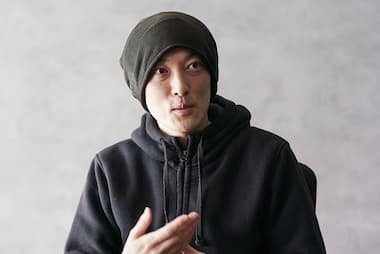Craftmanship
Craftsmen
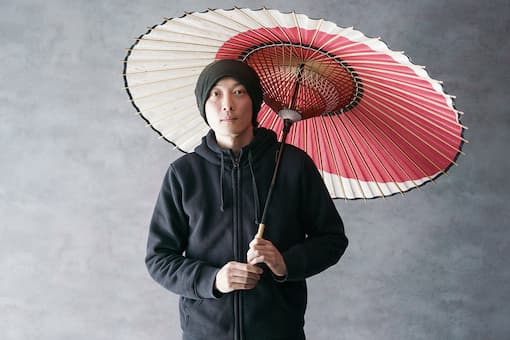
Japanese Umbrella Craftsman
Lives in Hiroshima City, Hiroshima Prefecture
"Amagumo-ya"
Ryohei Yoshihara
Promotes traditional Japanese crafts by designing "Sankaku"umbrellas
from origami cranes that embody the wish for peace
Q. There are very few Japanese umbrella craftsmen in Japan, and you are the only one in Hiroshima Prefecture. What led you down this path?
When I was 23, I visited Venice, Italy. Someone I met there who spoke Japanese asked me many things about Japan, and I was embarrassed by how little I could tell them. So, when I returned to Japan, I researched traditional crafts to learn more about Japanese culture. That was when I learned about Japanese umbrellas. I genuinely thought they were beautiful and wanted one. So, I spent a year studying the basics of Japanese umbrellas at the Wagasa Denshokan (Folklore Umbrella Museum) in Tottori Prefecture. After that, I returned to Hiroshima and acquired the necessary skills by learning from umbrella craftsmen and disassembling old umbrellas. I've held solo exhibitions and participated in a variety of events to share my designs, while working hard on production at my studio in Hiroshima City.
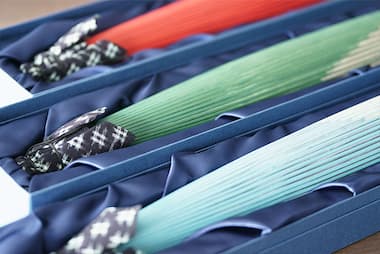
Q. Tell us about your Sankaku umbrellas.
Sankaku umbrellas are made from origami cranes. These cranes were folded with Japanese washi paper and embody a wish for peace. I was asked to be part of a project that was focused on sharing with the world this wish for peace embodied in origami cranes, but in a different form. So, I took on the challenge of making these umbrellas.
Sankaku umbrellas are paper umbrellas with a bull's eye design. They are characterized by their gorgeous designs and the patterns woven with decorative threads on the inside.
Origami cranes that the City of Hiroshima gives me are shredded into small pieces and scattered on washi paper. Traditional washi paper craftsmen use this shredded paper for the paper-making process (soaked to change to pulp, spread thin, and dried) to make Sankaku umbrellas. The thoughts and feelings of many different people are deeply embedded into each of these one-of-a-kind umbrellas.
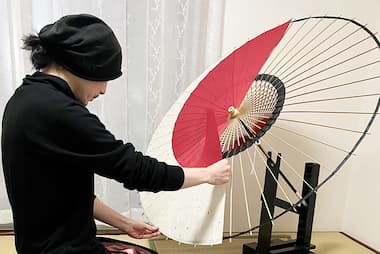
Q. Sankaku umbrellas were used during the Partners' Program at the G7 Hiroshima Summit.
In May 2023, Japanese history and traditional culture were introduced at Itsukushima Shrine on the second day of the Partners' Program at the G7 Hiroshima Summit. I was very proud to see the spouses of the heads of state posing with Sankaku umbrellas in front of the Great Otorii Gate.
Q. What are the characteristics of Japanese umbrellas, and the techniques used to make them?
Japanese umbrellas are noteworthy for their intricate ribs, compared to plastic umbrellas. The ribs are made of natural bamboo. To ensure that the ribs align perfectly when the umbrella is closed, a single length of bamboo is split into 44 pieces to assemble the structure. Multiple threads are woven into the inner ribs to provide both reinforcement and decoration. Another characteristic of Japanese umbrellas is that the structure allows them to be closed in two positions, so they can be closed halfway when passing people on the street. When I understood how each of these mechanisms work, I was amazed at how well people in the past thought things through.
I order many of the materials used to make these umbrellas, such as the rod, the bamboo ribs, and the runners, which hold the ribs together, from Gifu Prefecture. It can be very difficult to procure these important materials. However, based on my past experience and the relationships I've cultivated, I'm able to procure them with confidence.
Many umbrella makers continue to use a system from the olden days, in which labor is divided among multiple craftsmen to make Japanese umbrellas. I work alone for the entire process, which can be difficult for many reasons. On the other hand, that makes it easy for me to respond to the wishes and needs of each client, such as the color and design of the Japanese washi paper, and the color of the thread. It takes about three months to make each umbrella, from start to finish.
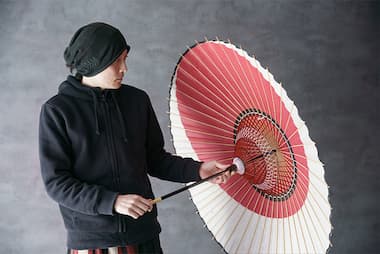
Q. Who uses Japanese umbrellas, and for what kind of occasions?
People tell me that Japanese umbrellas make a different sound than plastic umbrellas when the rain hits them. Many people also appreciate the beauty of these umbrellas, and want to use them for lighting designs or interior decoration. If the ribs break or the Japanese washi paper is torn, the umbrella can be repaired and used for a long time. I have long relationships with my customers.
My umbrellas are used as parasols when people go out in kimonos and for other special occasions. The surface of the washi paper is coated with a special oil that allows it to be used on rainy days, so some people use them as their daily umbrellas.
Q. What are your plans for the future?
I hope there will be more opportunities for many people to see Japanese umbrellas so that they become even more well known. Since these umbrellas are uniquely designed and built for each individual, the owners use them with care. This makes it an environmentally friendly handicraft. As they become more well known, I believe this will help solve the shortage of Japanese umbrella craftsmen as well as those who manufacture the materials. This will help us pass on a beautiful traditional craft of ancient Japan.
It is up to me to make the most of the materials that many craftsmen create. And I as a Japanese umbrella craftsman am the only person who has direct contact with our customers. I get very nervous when I hand over a completed umbrella, but it is also my favorite moment. My customers' happiness is what motivates me to make the next Japanese umbrella. I will continue to do my best to impress people with my Japanese umbrellas.
